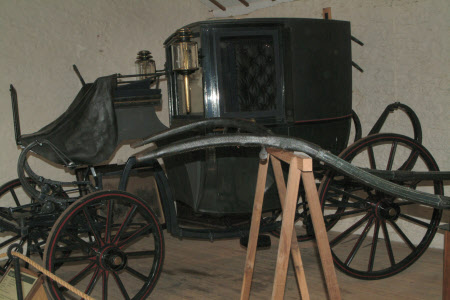Single brougham
Turrill and Sons
Category
Carriages & other vehicles
Date
1860 - 1890
Materials
Painted wood and leather body with morocco leather upholstery and four iron shod wheels.
Measurements
169 x 353 x 206cm (5ft 6 1/2in x 11ft 7in x 6ft 9in)
Place of origin
London
Order this imageCollection
National Trust Carriage Museum
NT 272873.1
Caption
A small and closed carriage, it would have been ideal for town driving. To give that added appeal it could be customised with “extras”, for example this Brougham has a drawer for calling cards, ash trays, and a bell to attract the coachman’s attention. It has small spikes on the rear bar to deter people from jumping on the back for a free ride.
Summary
Single Brougham built for the Marquess of Bute by Turrill and Sons between 1860 and 1880. Single Brougham (four wheels) for a single or pair of horses. The body is of an angular profile with sunk footboard between moulded brackets, and is on an iron perch with C springs and under springs. The coachmanss seat has rails and a hinged heel board. There is a pole through the top rail for the coachman’s communication cord. The roof and upper panels are covered in leather. On the back are painted iron body hoops. The box seat has a leather storm apron. Painted in a livery of dark green with red lining and with Bute crest 'Avito vinet honore' (He flourishes by ancestral honours).
Full description
The Brougham was named after Lord Brougham, who designed the prototype of this closed carriage in 1838. This example, built by Turrill & Sons, South Audley St., Grosvenor Square, London, was an ideal town carriage. A single Brougham seats two, and a double Brougham has an additional front seat and can carry four. In 1810 Obadiah Elliot registered a patent for his idea of mounting four-wheeled carriages on elliptic springs, instead of the large, heavy and expensive perch undercarriages previously used, and this new principle was adopted for all relatively small four-wheeled carriages. Though much cheaper and very practical, this new development was not as comfortable, and certainly not as stylish. In 1840 the first brougham was built that was mounted on a wrought iron perch with C springs and under springs which had the added advantage of showing that the owner could afford this much more expensive style and extra comfort. This is an example of this style. It was one of several carriages donated by the Marquis of Bute. It was probably built with no brake, and probably originally had a drag shoe, like the Marquis’s Victoria, and the brake was probably added later. It has some very attractive interior fittings including a bell to attract the coachman’s attention. There is also a cord that attaches to the coachman’s finger for the same purpose.
Marks and inscriptions
Stamped on top of axle arm of near front wheel : TURRILL LONDON Brass plate (possibly brazed on to earlier axle cap) : TURRILL & SONS – 68. SOUTH AUDLEY ST. W – On candle holder caps. : TURRILL & SONS LONDON Brass plate on bottom part of panel blind. : TURRILL & SONS, To her Majesty, 67 South Audley St., Grosvenor Sq.re On front nearside axle components.: P On front offside axle components.: P On rear nearside axle components.: P On rear nearside axle components.: P
Makers and roles
Turrill and Sons, coach builder
